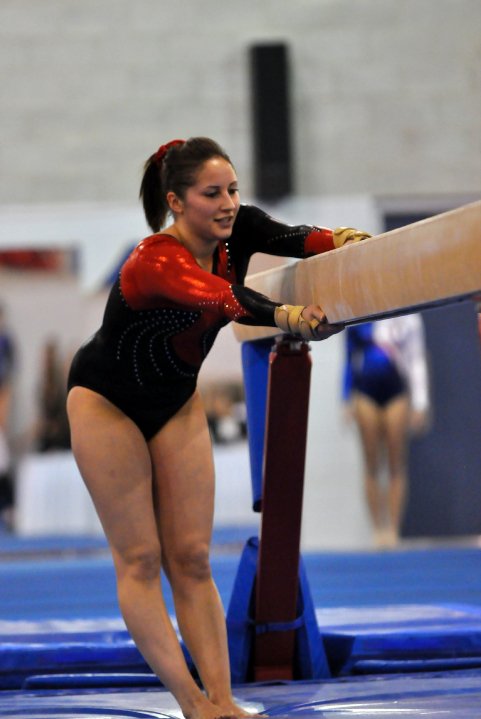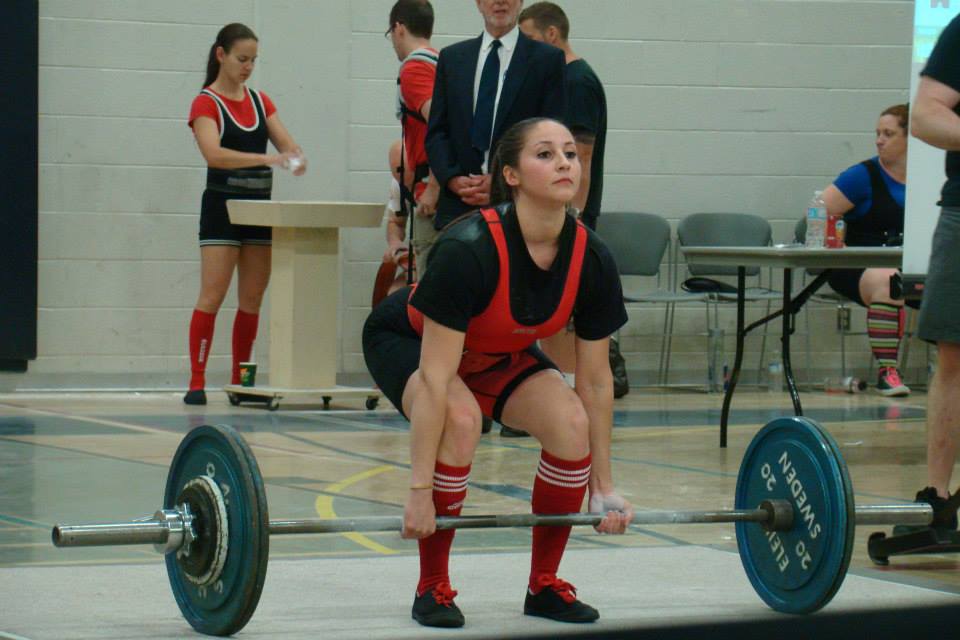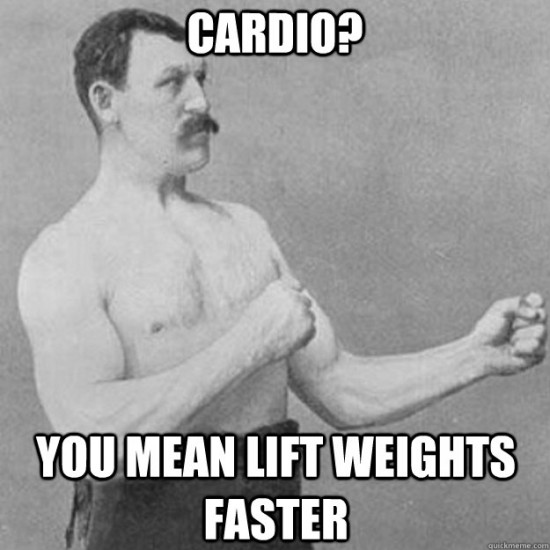 When you’ve done a particular sport your entire life, your identity naturally becomes intertwined with it.
When you’ve done a particular sport your entire life, your identity naturally becomes intertwined with it.
Take Tiger Woods – his name will always be tied to golf.
Or how about Michael Jordan? Known as the greatest basketball player ever (I also think think he should be remembered as a successful businessman. The Air Jordan brand was a stroke of marketing genius).
In a similar fashion, Miriam was always known as a gymnast to all her friends and family. And rightfully so – she trained in the sport for over 10 years.
But when she suffered a nasty knee injury during her final years as a competitive athlete, that identity was thrown into the air. After she recovered, Miriam found a new sport to call home – one with a lot of similarities to her previous athletic endeavour: Allstar Cheerleading (at Guelph University).
While going from an individual sport to a team based one has its challenges, she was still able to tumble, dance and jump. So naturally, she excelled throughout her time with the Guelph Gryphons.
 After graduating, the cheerleading chapter came to a close but Miriam kept herself active through different recreational sports and the odd thrill seeking adventure such as skydiving.
After graduating, the cheerleading chapter came to a close but Miriam kept herself active through different recreational sports and the odd thrill seeking adventure such as skydiving.
But that wasn’t enough.
Some people are just born to be competitors, and as a coach, I always make an active effort to keep an eye out for anyone that has that internal spirit of competition.
Having known Miriam for the better part of a decade now, I always knew she had that spirit. Trust me, it’s really hard to be a high level competitive gymnast without having the will to win and the work ethic that goes along with it.
Just under two years ago, I brought her into the gym so she could tag along with my workouts. I made no special plan for her, nor did I modify any of the exercises or workouts just because she was a lady. I myself was preparing for a Powerlifting meet and thus, if she wanted to workout with me, she would do the lifts I would do.
This means if I was squatting, she was squatting. If I was benching, she would bench. If I deadlifted, she would learn how.
Her initial goal was to stay fit and lift correctly, but it didn’t take long for Miriam to make significant strength gains. Once I helped her nail down her technique, the PR’s kept rolling in. Granted, while newbie gains are normal for any new lifter, they don’t last for more than a few months. Good technique and good programming are the cornerstone to helping a lifter make the most out of their first few months.
Once her deadlift hit 250 lbs and her squat was topping 200 lbs, I knew that she had to do at least one Powerlifting meet. I told her that I’d prep her for it from top to bottom, and that it would be a small local meet. She agreed.
 We set zero expectations other than to go and lift some weights, but that was all it took – the lifting bug bit her hard, and a top-ranked female powerlifter was born.
We set zero expectations other than to go and lift some weights, but that was all it took – the lifting bug bit her hard, and a top-ranked female powerlifter was born.
Since that time, Miriam has earned a gold medal, broken provincial bench press records, gotten drug tested, and just recently came 5th at her very first Canadian Powerlifting Nationals.
The Nationals were also her first time competing at the 57kg (125lbs) weight class – which required a cut of about 20 lbs.
Here’s How We Did It
While I get a lot of questions on how I structure Miriam’s workouts, I should start by saying that work ethic and a competitive mentality is something you should either already have, or be willing to cultivate.
One of Miriam’s jobs is to work security at a local bar called Nashville North, and she usually doesn’t get home from these shifts till 3-4am. And yet despite such challenging work hours, she’s never missed a workout nor cheated on any of the diet plans that I’ve laid out for her. Something to keep in mind.
Miriam’s Secret Weapon: Amazing Sponsors
Getting Miriam qualified for Nationals was one thing, but actually getting her to the venue in beautiful St John’s Newfoundland was a whole different story. A story that wouldn’t have been possible without her amazing sponsors. Their generous contributions allowed us to travel and compete against Canada’s best, and I wanted to take this opportunity to give them a special shout out.
Nashville North – This is the country bar you want hit up if you live in the Greater Toronto Area. I’ve been going there for years, and I’ve never had a bad time. Wednesday nights you can go and learn line dancing, Thursday nights is top 40 and wet T-shirt contests, and Saturday nights are all about country, so bring your cowboy hats. Oh, and that’s just a tip of the iceberg – they’re always hosting special events that you won’t want to miss. As a bonus, Miriam works security at the door, so you can go ask for her autograph in person ;) A special thanks to Kit Andrew, the owner.
Hustle & Muscle – An upcoming clothing line with some truly amazing T shirts. They also sponsor MMA events, which is a big plus since Miriam and I are huge fight fans. Check em out! A big thanks to Ivan Whittaker.
University Of Guelph Cheerleading – Our final big thank you goes out to Cari-Ann Young and Aaron Murphy – coaches of the Guelph Gryphons Cheerleading team. Not only have they lead the Gryphons to a National Championship victory in the past, but the fact that they provided this much support to one of their previous athletes shows how big of a heart they truly have.
Here’s a recap of Miriam’s lifts at Nationals
Miriam’s experience in her own words: “I retired from artistic gymnastics in April of 2010 due to a knee injury. Started competing in Powerlifting in Feb of 2014 with the goal of making it to nationals in 2015. This was a first of many experiences for me… not only was it my first Powerlifting nationals, but it was my first time competing in 57kg, as well as my first time competing in Open. The whole experience was incredibly motivating for me. It was such an honour to be sharing that platform with the best lifters of the nation. I learned so much from the other athletes and judges who took the time to talk to me and give me strong advice. Even though leading up to the competition I was a nervous wreck, I was surprised with how calm I was during the actual meet. I think this is because of the tremendous amount of support I had coming from back home. My goal was to land in the top 5 and have fun… mission accomplished. I owe a huge thank you to my sponsors: Nashville North, Hustle & Muscle, and the University of Guelph Cheerleading coaches for making this trip to Newfoundland possible in the first place… and especially, my best friend and coach, Sahil Mulla, who is the reason why I was even qualified for nationals to begin with. Here’s to many more!”
The Training
Instead of listing each of Miriam’s specific workouts, I figured it would be best to reveal the training principals on which they’re based. If you’ve never done any type of strength training in the past, this will be a good primer for you. And if you’re an experienced lifter, you may just pick up a few nuggets to implement in your own plan.
The First Rule Of Strength: Instead of trying to become bigger, become more efficient
Most people think strength is the byproduct of having big muscles. And that’s partially true – the bigger you are, the heavier the weight you’ll be able to lift since you become a better counter weight for the loaded barbell, and you have more muscle in general. But in Powerlifting, the goal is to get stronger while staying as light as possible. This is why the nervous system plays a significant role during training.
Afterall, it is the nervous system that tells your muscles what to do – make it more efficient, and you’ll get stronger without having to become big. This is the general philosophy behind how I design strength programs.
While there are a multitude of ways to accomplish this, the general rule of thumb is to lift heavy, and do it often using low rep sets. So instead of doing 3 sets of 8, flip the script and do 8 sets of 3 with lot more weight. You’ll get infinitely stronger, without putting on too much mass.
Second Rule Of Strength: If you can lift a light weight quickly, you can lift a heavy weight slowly
If you look at any of the elite, record-shattering lifts, 99% of the time they look slow and lethargic. But I assure you that the intent of the lifter is anything but.
When Miriam is warming up her deadlifts with just one plate, I’m constantly reminding her to pretend that there’s hundreds of pounds on the bar, and that her intent should be to rip it off that floor as quickly as possible.
This intent carries over and pays dividends when she’s actually pulling over 300 pounds. Training for speed does what I talked about in the first rule – makes your nervous system more efficient.
Oh, and remember that you cannot lift a weight quickly without suffering injury unless your technique is on point. So speed and technique go hand in hand. Well… unless you’re into CrossFit.
Third Rule Of Strength: Find your weaknesses, then work them into submission
 Because of Miriam’s above-average levels of flexibility, one of her weaknesses with the deadlift was that her hips would shoot up, and she would essentially do a stiff legged pull. For most people this would put too much strain on the hamstrings and lower back (especially when the load is heavy), but for her it was a natural movement.
Because of Miriam’s above-average levels of flexibility, one of her weaknesses with the deadlift was that her hips would shoot up, and she would essentially do a stiff legged pull. For most people this would put too much strain on the hamstrings and lower back (especially when the load is heavy), but for her it was a natural movement.
In fact, my friend Steven and I realized she hardly ever bent her legs during normal daily tasks. For example, if she needed to pick something off the floor, she’d rely on her flexibility and just reach down. No bend in the legs whatsoever. This motor pattern had to go, as it wasn’t ideal for someone who’s aiming to pull a significant amount of weight.
Naturally, this also made her deadlifts slow off the floor. The solution I gave her (and something we still work on) is that she needs to consciously bend her legs for all normal tasks throughout the day, along with lots of speed deadlifts with a hip-down motion and deficit pulls.
This is just one example of finding a sticking point and using assistance exercises to eliminate them. Every person has their own unique problems. To help you out, below are a list of some of my favorite assistance exercises you can use to eliminate any weak spots in your lifts.
Squat Assistance Exercises:
- Weighted Squat Jumps (One of the few exercises where a Smith machine is warranted)
- Heavy Rack Squats (also known as squat lockouts)
- Low Rack Squats
- Barbell Front Squats
- Barbell Pause Squats
Bench Assistance Exercises:
- Plyometric Bench Press (Definitely use a Smith machine as the bar has to leave your hands)
- Board Presses (or partial presses if you don’t have a board)
- Barbell Bench Press (with chains or bands)
- Close Grip Bench Press
- Overhead Press
- Incline Bench Press
Deadlift Assistance Exercises:
- Deficit Deadlifts
- Trap Bar Deadlift
- Rack Pulls
- Pendlay Rows
- Barbell Good Mornings
- Dumbbell Jumping Deadlift
This is by no means a complete list of assistance exercises, as that would take up an entire article all by itself. But I wanted to provide a list that would give you the best bang for your buck. If you include these in your training, your lifts will go up as they pretty much cover all of your bases. In fact 80% of Miriam’s workouts consist of these exercises in some way shape or form.
The other 20% are things that are uniquely specific to her body type and limb leverages.
Fourth Rule Of Strength: Avoid slow and steady state cardio
 Your body is really good at adapting to stress; put 200 lbs on your back, and while you might only be able to squat that for one rep today, you’ll be doing sets of five if you keep at it.
Your body is really good at adapting to stress; put 200 lbs on your back, and while you might only be able to squat that for one rep today, you’ll be doing sets of five if you keep at it.
This is what training is – applying a specific type of stress to the body so that it adapts to it in a way that’s predictable and dependable.
So if you want to get strong, lifting heavy things should take up 80-90% of your training time. When you do slow and steady state cardio (such as jogging for an hour), you’re giving your body a type of stress signal that says “fire muscles at a slow pace, and burn calories sparingly so we can survive this hour of hell.”
As the famous Canadian strength coach Charles Poliquin once said, “You can’t ride two horses with one ass.”
Or in other words, don’t try and be a jack of all trades.
Now if you enjoy running, this doesn’t mean you should give it up completely. But just make sure you’re not mixing and matching two different stress signals under a small timeframe.
In other words, don’t do a one hour jog before or after a heavy lift session. Instead, wait at least 4-6 hours or do it on another day as this will allow your body to adapt to the stress you put it through earlier. Alternating cardio and lifting days would be the best option if cardio is something you don’t want to give up. Personally I hate cardio, so lifting and watching my diet is all I do.
It just so happened to be my luck that Miriam on the other hand, totally loves doing cardio. But you’ll never find her loitering along on a treadmill. Instead, her cardio consists of high intensity movements such as sprints, jumps, rope skips, plyometrics etc. Fortunately, this quick burst type of training actually compliments her heavy lifting sessions.
While there are more strength training principles and rules, listing them all here is beyond the scope of this article. I will say that if you manage to implement these four, your strength levels will be miles ahead of most people. Now let’s talk about how you should eat.
The Diet
When weight loss is the goal, what’s the first plan of action that most people tend to consider?
To start working out.
Increasing the level of activity is the general go-to for a majority of the population in some way shape or form. But that’s the wrong way to go about it. I can confidently say that about 60-70% of weight loss results come from making changes in the diet.
You tell me what’s easier: To cut out an entire plate’s worth of spaghetti and meatballs, or do an hour of intense circuit training?
One decision takes 3 seconds to make and requires almost zero work (except maybe managing hunger levels) and the other requires an hour’s worth of effort, sweat and pain.
Now granted, doing both would be the ideal choice but I just wanted to illustrate the effectiveness of simply cutting out calories.
How do I know this works?
Because I’ve been coaching people, and helping them make weight for years – especially when it counts. Miriam is a perfect example: she had to go from 145 to 125 for her Powerlifting Nationals to compete in the weight division she was signed up for. If she didn’t make weight, all of the months worth of work would be flushed down the drain, as she wouldn’t be allowed to compete.
Weight cutting is serious business. It’s as important as training for any of the big lifts. Below is the general process I used to help her cut 20 lbs while still helping maintain her strength levels.
Phase 1: Caloric Restriction
It doesn’t matter whether someone wants to make weight for wrestling, mma, powerlifting or just wants to drop body fat for the summer. The very first and most-often used tool in my toolbox is caloric restriction. The amount of calories I cut depends on the individual – a 200 pound guy would obviously have a vastly different cut than Miriam would.
For the average lady who wants to drop weight at a reasonable rate, creating a deficit of about 250 calories per day is a good starting point. Track your weight weekly, and if it’s working, keep going. If it’s not, you can start to get more aggressive. A typical deficit pattern that I use: 250, 500, 700, 900, 1000.
To put into perspective, 250 calories is roughly equal to two bananas. Miriam’s training stayed unchanged during this phase, as weight was coming off. And when things are working, I don’t tend to mess with it.
Phase 2: Carb Cycling
 Your body loves carbohydrates, that’s just a fact. However, carbs need somewhere to go. Without getting too technical, you should know that when you take in carbs, they will either be burnt off, be excreted as waste, or be stored as fat.
Your body loves carbohydrates, that’s just a fact. However, carbs need somewhere to go. Without getting too technical, you should know that when you take in carbs, they will either be burnt off, be excreted as waste, or be stored as fat.
There are no other options.
Once you input something into your body, you’re at the mercy of the first law of thermodynamics. This means eating a tonne of carbs on days you plan on being particularly inactive is a bad idea.
So the solution is to increase carb intake on days you train, then reduce them on days you don’t. The exact amount of carbs to eat depends on the individual and the type of training they do. I use a specific formula for my clients, but to keep things simple, below are some highly-effective guidelines you can follow.
On Training Days
Stick to simple and sugary carbs since they provide two major benefits:
One: Hit your bloodstream quickly and are available as fuel for your workouts.
Two: Help replenish muscle glycogen levels at a rapid pace, thus speeding up recovery.
Think low fibre fruits, sugary cereals, pastry, candy etc. Basically, anything that the general population considers “unhealthy.” But be warned, quantity does matter.
Having a donut half an hour before a heavy deadlift session? Awesome.
Having three? Not so much!
In your entire day, having 3-4 servings of simple carbs should serve you well. It should also go without saying that your training shouldn’t resemble a leisurely walk in the park where the heaviest load lifted are the flowers you plucked. You need to bust your ass, and walk out of the gym like you just wrestled a bear while surviving a head on collision with a tank.
On Rest Days
These are the days where you’d eat the “healthy” type of carbohydrates such as oatmeal, brown rice, high fibre cereals etc. These are also known as complex carbs. When it comes to quantity, limit yourself to about 2-3 servings throughout the day. You want just enough carbs to help with recovery and aid normal body functions, but not a surplus which will be stored as fat.
Why complex carbs? Because they take hours to digest, which means the glycogen hits your bloodstream at a slow and steady pace, keeping your insulin levels in check.
Note: Phase 2 won’t work without Phase 1. You still need to be in a caloric deficit as carb cycling isn’t magic.
On Protein
Regardless of who’s nutrition plan I’m making, protein almost always stays near the high range. My rule of thumb is to make sure everyone gets at least 1 gram per pound of lean body mass. So if you weigh 200 lbs and have a body fat level of 10%, then your lean body mass is 190 lbs. This means you would take in 190 g of protein per day at the minimum, no exceptions.
Phase 3: Strictly Low Carb
At some point, cutting out calories and cycling your carbs will stop working. I mean, there are only so many calories you can cut until you’re pretty much eating nothing, or until your body has had enough and will refuse to drop weight. Female bodies in particular, can be rather stubborn at times (go figure).
This is when I introduce phase 3, which is a constant low-carb approach.
The amount of carbs one should aim for during this phase is around 30-50g per day for 7-10 days MAX. For a majority of clients, this three phase process is more than adequate to help them make weight (or burn fat quickly for a vacation). During phase 3 I will also bump the protein and fat requirements should the total calories drop too low.
So why cut carbs so drastically?
Because for every gram of carbohydrate that you eat, your body holds on to about 3 grams of water. And water is heavy, which means you need to make sure your body only hangs on to the bare minimum amount of fluid that it needs. Assuming protein intake is adequate, phase 3 should get you as lean and light as you need to get without sacrificing your strength levels too much.
 There are more advanced methods such as water loading, dehydration via diuretics, and using saunas and hot tubs to induce sweating. But those methods are only useful for making scale weight, and are short term solutions. I’m talking a time frame of hours.
There are more advanced methods such as water loading, dehydration via diuretics, and using saunas and hot tubs to induce sweating. But those methods are only useful for making scale weight, and are short term solutions. I’m talking a time frame of hours.
You see, after dehydration you need proper rehydration. If you mess that up, expect cramps, light headedness, drop in blood pressure and possible fainting. This means it should be done under supervision of a coach.
Unless you need your weight to be precise to the tenth of a pound, using the basic three phases listed above will get you the results you want. It’s how I was able to get Miriam damn close to her required weight. Then the final few pounds were shed by getting her body to rid of excess water.
Final Thoughts
One of the most common reactions I get from people when I show them training footage of Miriam (or any of my other athletes) is, “Wow that’s incredible, I could never do that!”
But the beauty of Powerlifting is that you can do that. I think everyone should consider competing in a small, local meet at least once in their lifetime. Not to win trophies or to aim for the top, but just to see what they’re capable of. It’s also a lot of fun, and the people a great.
In fact, Powerlifting is one of the safest sports you can compete in, and the best place to try for a new max – you’re surrounded by not one, but a minimum of three highly experienced spotters, ready to save you at a moment’s notice. It gives you all the confidence in the world to go balls to the wall.
And don’t think it’s only for youngsters and talented ex-gymnasts. You can be an athlete in this sport for a long time, sort of like in Golf.
Seriously, Miriam and I have met a few competitors in the Master’s divisions, and it’s truly inspiring to see grandmothers and grandfathers crush some truly impressive weight. All you need is the right plan to follow, and the will to implement it.
If you’d like my personal assistance, I offer a service called the Strength Training Blueprint. This is where I design a fully customized training plan from top to bottom to help you achieve your goals. Whether you need help with your very first Powerlifting meet, or you want to be the strongest mom or dad on the block, I’ll work with you 1-on-1 to help make it happen. Click here to learn more about it.
In the mean time, I hope you enjoyed the read. Should you have any questions for Miriam or myself, please drop them in the comment section below. Cheers!
Coach Sahil M.
Founder, Hardcore Training Solutions
National Deadlift Record Setter
Powerlifting & Gymnastics Coach
Author, Flawless Fitness 2 & The Cheer Diet
